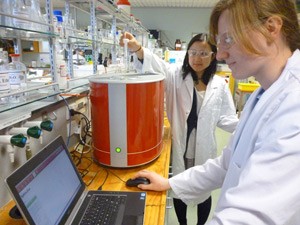Magritek, a leading worldwide provider of compact NMR and MRI instruments, have launched the first six in a series of laboratory experiment manuals to help teach undergraduate students about the practical benefits of using Nuclear Magnetic Resonance, NMR.
 The Magritek Spinsolve benchtop NMR is an ideal tool for every chemistry teaching laboratory.
The Magritek Spinsolve benchtop NMR is an ideal tool for every chemistry teaching laboratory.
In collaboration with the School of Chemical and Physical Sciences at Victoria University of Wellington, Magritek have developed a set of student teaching laboratory manuals. These are aimed at second and third year organic Chemistry labs. Students will use the Spinsolve® benchtop NMR spectrometer to analyse their own samples with simple one- and two-dimensional NMR methods.
Getting NMR into the hands of students at an early stage is just part of the evolution in the world of NMR. The launch of benchtop NMR spectrometers like the Magritek Spinsolve series of instruments in 2013 has changed the face of education in chemistry with institutes around the world being able to adopt a low-cost, low-maintenance system to bring practical teaching into undergraduate teaching laboratories.
There are six manuals in this first release and they are available for free download at the Magritek web site. Here is a brief summary of what is available:
- Synthesis and Reactions of Ferrocene: This experiment aims to provide experience in the synthesis, isolation, purification and characterisation of organometallic compounds. Purification techniques include distillation, sublimation, chromatography and crystallisation. Students will also develop their synthetic skills using inert atmosphere techniques.
- Synthesis of p-Nitroaniline via a Multi-Step Sequence: Here students gain experience in the synthesis, isolation, purification and characterisation of simple aromatic compounds. In particular, they will study aromatic substitution reactions in which functional groups greatly influence further substitution of monosubstituted benzenes. The main characterisation technique utilised in these experiments is 1H NMR spectroscopy using the Spinsolve benchtop NMR spectrometer.
- Extraction of Essential Oils from Spices using Steam Distillation: Students will isolate and purify the key chemical compounds that contribute to the aroma and flavour of the spices. The compounds will then be characterised by 1D and 2D NMR spectroscopy.
- Separation of Acidic, Basic and Neutral Compounds: Students will gain practical experience in the separation and purification of simple organic compounds using liquid/liquid extraction and acid/base extraction techniques. The various separation steps will be followed by 1H NMR spectroscopy to determine and characterise the compounds present.
- Measuring Lipophilicity with NMR: In this experiment the 1-octanol/water partition coefficient (Pow) of some common solvents will be measured. Students will quantify the amount of the chosen analyte in water before and after the addition of 1-octanol layer by NMR spectroscopy. This information will allow the calculation of the Pow and log(Pow) of the analytes.
- The Aldol Condensation: The objective of this experiment is to understand aspects of carbonyl chemistry and carbon-carbon bond formations using the classical, well-known aldol condensation reaction as an example. One- and two-dimensional NMR spectra will be used to characterise the reaction products and evaluate their chemical structure and geometry.
Download all of these manuals from the Magritek web site where you can also obtain full details of the Spinsolve benchtop NMR spectrometer and the full range of analytical products from Magritek, visit, www.magritek.com/spinsolve